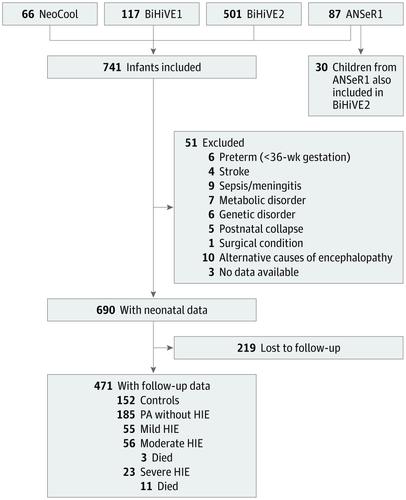当前位置:
X-MOL 学术
›
JAMA Pediatr.
›
论文详情
Our official English website, www.x-mol.net, welcomes your
feedback! (Note: you will need to create a separate account there.)
Two-Year Neurodevelopmental Outcomes After Mild Hypoxic Ischemic Encephalopathy in the Era of Therapeutic Hypothermia
JAMA Pediatrics ( IF 24.7 ) Pub Date : 2020-01-01 , DOI: 10.1001/jamapediatrics.2019.4011 Mikael Finder 1, 2 , Geraldine B Boylan 3, 4 , Deirdre Twomey 3, 4 , Caroline Ahearne 3, 4 , Deirdre M Murray 3, 4 , Boubou Hallberg 1, 2
JAMA Pediatrics ( IF 24.7 ) Pub Date : 2020-01-01 , DOI: 10.1001/jamapediatrics.2019.4011 Mikael Finder 1, 2 , Geraldine B Boylan 3, 4 , Deirdre Twomey 3, 4 , Caroline Ahearne 3, 4 , Deirdre M Murray 3, 4 , Boubou Hallberg 1, 2
Affiliation

|
Importance
Therapeutic hypothermia reduces risk of death and disability in infants with moderate to severe hypoxic ischemic encephalopathy (HIE). Randomized clinical trials of therapeutic hypothermia to date have not included infants with mild HIE because of a perceived good prognosis. Objective
To test the hypothesis that children with mild HIE have worse neurodevelopmental outcomes than their healthy peers. Design, Setting, and Participants
Analysis of pooled data from 4 prospective cohort studies in Cork, Ireland, and Stockholm, Sweden, between January 2007 and August 2015. The dates of data analysis were September 2017 to June 2019. Follow-up was performed at age 18 to 42 months. In this multicenter cohort study, all children were born or treated at the tertiary centers of Cork University Maternity Hospital, Cork, Ireland, or Karolinska University Hospital, Stockholm, Sweden. In all, 690 children were eligible for this study. Exposures
At discharge, all children were categorized into the following 5 groups using a modified Sarnat score: healthy controls, perinatal asphyxia (PA) without HIE, mild HIE, moderate HIE, and severe HIE. Main Outcomes and Measures
Cognitive, language, and motor development were assessed with the Bayley Scales of Infant and Toddler Development, Third Edition (BSITD-III). The BSITD-III scores are standardized to a mean (SD) of 100 (15), with lower scores indicating risk of developmental delay. Results
Of the 690 children eligible for this study, 2-year follow-up data were available in 471 (mean [SD] age at follow-up, 25.6 [5.7] months; 54.8% male), including 152 controls, 185 children with PA without HIE, and 134 children with HIE, of whom 14 had died. Infants with mild HIE (n = 55) had lower cognitive composite scores compared with controls, with a mean (SD) of 97.6 (11.9) vs 103.6 (14.6); the crude mean difference was -6.0 (95% CI, -9.9 to -2.1), and the adjusted mean difference was -5.2 (95% CI, -9.1 to -1.3). There was no significant difference in the mean cognitive composite scores between untreated children (n = 47) with mild HIE and surviving children with moderate HIE (n = 53) treated with therapeutic hypothermia, with a crude mean difference for mild vs moderate of -2.2 (95% CI, -8.1 to 3.7). Conclusions and Relevance
This study's findings suggest that, at age 2 years, the cognitive composite scores of children with a history of mild HIE may be lower than those of a contemporaneous control group and may not be significantly different from those of survivors of moderate HIE treated with therapeutic hypothermia.
中文翻译:

治疗性低温时代轻度缺氧缺血性脑病后的两年神经发育结果
重要性 低温治疗可降低患有中度至重度缺氧缺血性脑病 (HIE) 的婴儿的死亡和残疾风险。迄今为止,治疗性低温的随机临床试验尚未包括轻度 HIE 婴儿,因为他们认为预后良好。目的 检验轻度 HIE 儿童的神经发育结果比健康同龄人更差的假设。设计、设置和参与者 2007 年 1 月至 2015 年 8 月期间在爱尔兰科克和瑞典斯德哥尔摩进行的 4 项前瞻性队列研究的汇总数据分析。数据分析日期为 2017 年 9 月至 2019 年 6 月。随访时间为18 至 42 个月。在这项多中心队列研究中,所有儿童都在爱尔兰科克市科克大学妇产医院的三级中心出生或接受治疗,或瑞典斯德哥尔摩卡罗林斯卡大学医院。总共有 690 名儿童符合这项研究的条件。暴露 出院时,所有儿童均使用改良的 Sarnat 评分分为以下 5 组:健康对照组、无 HIE 的围产期窒息 (PA)、轻度 HIE、中度 HIE 和重度 HIE。主要结果和措施 认知、语言和运动发育通过贝利婴幼儿发育量表第三版 (BSITD-III) 进行评估。BSITD-III 分数标准化为 100 (15) 的平均值 (SD),分数越低表示发育迟缓的风险。结果 在符合本研究条件的 690 名儿童中,471 名(平均 [SD] 随访年龄,25.6 [5.7] 个月;54.8% 男性)获得了 2 年的随访数据,其中包括 152 名对照,185 名患有没有 HIE 的 PA,以及 134 名患有 HIE 的儿童,其中14人死亡。与对照组相比,轻度 HIE 婴儿 (n = 55) 的认知综合评分较低,平均 (SD) 为 97.6 (11.9) 比 103.6 (14.6);粗平均差为 -6.0(95% CI,-9.9 至 -2.1),调整后平均差为 -5.2(95% CI,-9.1 至 -1.3)。未治疗的轻度 HIE 儿童(n = 47)与接受治疗性低温治疗的中度 HIE 存活儿童(n = 53)的平均认知综合评分没有显着差异,轻度与中度的粗平均差异为 -2.2 (95% CI,-8.1 到 3.7)。结论和相关性 本研究的结果表明,在 2 岁时,
更新日期:2020-01-01
中文翻译:

治疗性低温时代轻度缺氧缺血性脑病后的两年神经发育结果
重要性 低温治疗可降低患有中度至重度缺氧缺血性脑病 (HIE) 的婴儿的死亡和残疾风险。迄今为止,治疗性低温的随机临床试验尚未包括轻度 HIE 婴儿,因为他们认为预后良好。目的 检验轻度 HIE 儿童的神经发育结果比健康同龄人更差的假设。设计、设置和参与者 2007 年 1 月至 2015 年 8 月期间在爱尔兰科克和瑞典斯德哥尔摩进行的 4 项前瞻性队列研究的汇总数据分析。数据分析日期为 2017 年 9 月至 2019 年 6 月。随访时间为18 至 42 个月。在这项多中心队列研究中,所有儿童都在爱尔兰科克市科克大学妇产医院的三级中心出生或接受治疗,或瑞典斯德哥尔摩卡罗林斯卡大学医院。总共有 690 名儿童符合这项研究的条件。暴露 出院时,所有儿童均使用改良的 Sarnat 评分分为以下 5 组:健康对照组、无 HIE 的围产期窒息 (PA)、轻度 HIE、中度 HIE 和重度 HIE。主要结果和措施 认知、语言和运动发育通过贝利婴幼儿发育量表第三版 (BSITD-III) 进行评估。BSITD-III 分数标准化为 100 (15) 的平均值 (SD),分数越低表示发育迟缓的风险。结果 在符合本研究条件的 690 名儿童中,471 名(平均 [SD] 随访年龄,25.6 [5.7] 个月;54.8% 男性)获得了 2 年的随访数据,其中包括 152 名对照,185 名患有没有 HIE 的 PA,以及 134 名患有 HIE 的儿童,其中14人死亡。与对照组相比,轻度 HIE 婴儿 (n = 55) 的认知综合评分较低,平均 (SD) 为 97.6 (11.9) 比 103.6 (14.6);粗平均差为 -6.0(95% CI,-9.9 至 -2.1),调整后平均差为 -5.2(95% CI,-9.1 至 -1.3)。未治疗的轻度 HIE 儿童(n = 47)与接受治疗性低温治疗的中度 HIE 存活儿童(n = 53)的平均认知综合评分没有显着差异,轻度与中度的粗平均差异为 -2.2 (95% CI,-8.1 到 3.7)。结论和相关性 本研究的结果表明,在 2 岁时,











































 京公网安备 11010802027423号
京公网安备 11010802027423号